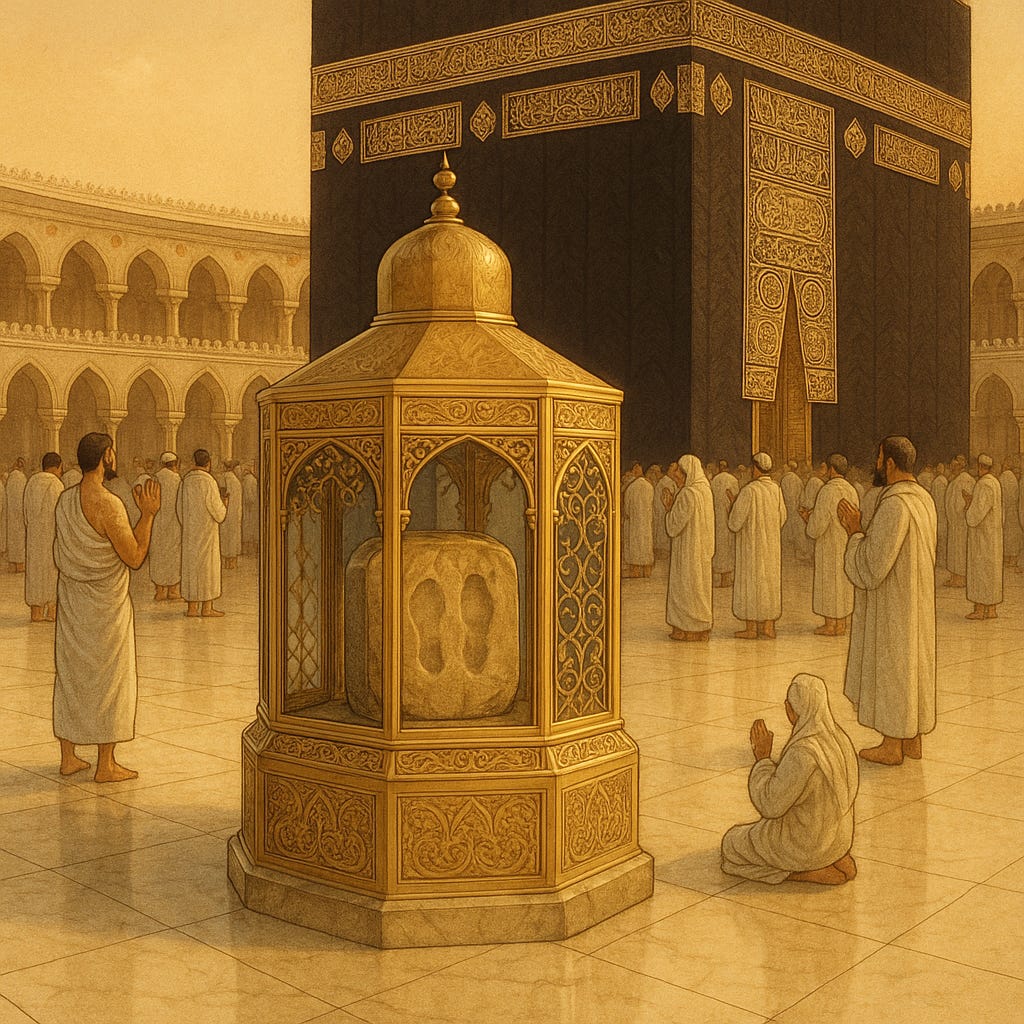Maqam Ibrahim: The Sacred Stone of Legacy and Prayer
The Miraculous Station of Prophet Ibrahim (AS) in Shia Tradition
Introduction
Maqam Ibrahim, or the Station of Ibrahim (AS), is a revered relic in Islam, intimately connected to the construction of the Holy Ka'bah in Makkah. This blessed stone, bearing the imprints of Prophet Ibrahim’s (AS) feet, stands as a testament to his unwavering faith and obedience to Allah’s command. Its story is woven into the rituals of Hajj and Umrah, and it holds a special place in Shia traditions.
The Divine Command and Construction of the Ka'bah
According to Islamic tradition, Allah commanded Prophet Ibrahim (AS) to build the Ka'bah as a sanctuary for humanity. Obeying this divine order, Prophet Ibrahim (AS) and his son Prophet Ismail (AS) began laying its foundations, using stones from the surrounding mountains of Makkah. As the walls of the Ka'bah rose, they became too high for Ibrahim (AS) to reach.
The Miracle of the Rising Stone
At this crucial moment, a miracle occurred: the stone upon which Ibrahim (AS) stood was made to rise by Allah’s will, enabling him to complete the upper walls of the Ka'bah. The stone softened under his feet, leaving behind clear imprints—a sign of Allah’s mercy and a lasting legacy for future generations. Once the Ka'bah was completed, the stone was initially placed on its eastern side.
Relocation and Preservation
Today, Maqam Ibrahim is enclosed in a gold-framed structure with reinforced glass. The original footprints are now covered by a silver alloy casing, with two deep imprints representing where Ibrahim’s (AS) feet once stood. The actual footprints are no longer visible to the public.
A Place of Prayer: Quranic Command and Ritual Practice
Maqam Ibrahim is not only a historical relic but also a place of worship. Allah commands in the Quran:
“And take the Maqam Ibrahim as a place of prayer.” (Quran, Surah al-Baqarah, Chapter 2, The Cow, Verse 125)
This verse establishes the practice of performing two rak’ahs of prayer at Maqam Ibrahim after completing the Tawaf during Hajj or Umrah. The Quran further narrates:
“And [mention] when We made the House a place of return for the people and [a place of] security. And take, [O believers], from the standing place of Abraham a place of prayer. And We charged Abraham and Ishmael, [saying], ‘Purify My House for those who perform Tawaf and those who are staying [there] for worship and those who bow and prostrate [in prayer].’”
(Quran, Surah al-Baqarah, Chapter 2, The Cow, Verse 125)
Shia Narrations
Shia hadith literature, such as Al-Kafi by Al-Kulayni, emphasizes the sanctity of Maqam Ibrahim. Imam Ja’far al-Sadiq (AS) is reported to have said:
“The Maqam Ibrahim is a stone from Paradise. If Allah had not concealed its light, it would have illuminated everything between the East and the West.” (Al-Kafi, vol. 4, p. 543)
Shia Muslims believe the original location of Maqam Ibrahim was right next to the Ka'bah. It also mentions a hadith from Imam al-Sadiq (AS) stating that Imam al-Mahdi (AS) will return Maqam Ibrahim to its original place upon his advent.
Conclusion
Maqam Ibrahim stands as a symbol of faith, sacrifice, and divine mercy. Its story, preserved in the Quran and the traditions of Islam, continues to inspire millions of pilgrims who visit the Holy Ka'bah each year. The stone not only marks a miraculous event in history but also serves as a perpetual place of prayer, connecting believers to the legacy of Prophet Ibrahim (AS).


